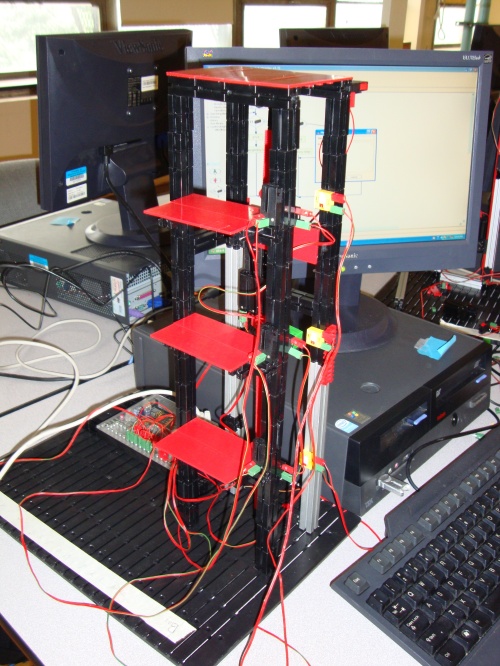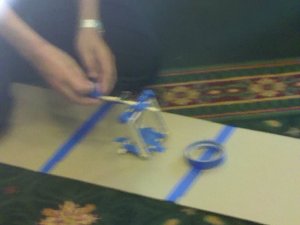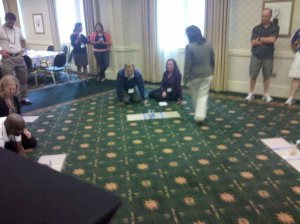In my school, I teach as a dual member of the math department and the Project Lead the Way
engineering department. Our students in engineering for the most part have chosen engineering as their pathway (at the end of their ninth grade year), and take the courses in the following sequence:
- Principles of Engineering (POE): fall, grade 10
- Introduction to Engineering Design (IED): spring, grade 10
- Computer Integrated Manufacturing (CIM): fall, grade 11
- Digital Electronics (DE): spring, grade 11
- Engineering Design and Development (EDD): spring, grade 12
Our school is unusual in offering POE as the first course. Although Project Lead the Way (PLTW) does not require a specific course sequence, most schools begin with IED.
Why do we do it differently?
Principles of Engineering, as can be gleaned from the course title, is a survey course, where students learn what engineering is all about. They learn about some of the types of engineering (civil, mechanical, materials, electronics/computer), by completing a major project in each area. They learn about the engineering profession. They learn about the engineering process (briefly: design, build, test, then refine). They get a sample of many aspects of engineering that will be studied in more detail in later courses.
Introduction to Engineering Design is not a survey course. Its focus is more narrowly on design, which leaves out the key steps of building, testing, and re-designing (based on the test’s results). Compared to POE, it does not give students as good a picture of what they can expect from our engineering pathway. The argument for IED first is that it does build students’ requisite engineering skills: skills in the design process, and skills in use of the Autodesk Inventor software. These skills are used in many of the later courses, and by actual engineers.
Math Math Math!
I feel strongly that POE is a better introductory course, though I would be thrilled to hear arguments for IED (or even for other courses) in the comments. However, there are some drawbacks to having POE first, and there are a few new ideas we are trying out in an attempt to overcome those drawbacks:
POE is very math-intensive. Most of our tenth graders are taking Geometry concurrent with POE, having passed Algebra I. This semester, I am teaching a class of ninth graders, many of whom are still in the midst of learning Algebra I. The mathematics in POE ranges from right-triangle trigonometry (usually not seen until Geometry class), to work with vectors (usually not seen anywhere in high school math, maybe in Algebra II or Precalculus), to variable substitution in formulas (Algebra I), to measurement (elementary school, though many students still struggle with reading a ruler), to work with parabolas and quadratics (Algebra II). What this means is that the POE teacher is often teaching these math skills before the student learns them in math class. Additionally, the use of such a multitude of math skills, often in combination1, requires a mathematical sophistication that most 9th-10th graders lack.
All in all, this sounds like an argument for leaving POE until the 12th grade! That way, students will have had Geometry and Algebra II, will have built up that mathematical sophistication, and may have taken / be taking a physics course. But this doesn’t seem realistic either, since POE is by nature an introductory survey course. It has hands-on projects that give students experience with and insight into the varied fields of engineering.
Here are two strategies I am trying out this year with my ninth graders, in an attempt to address the mathematics dilemma:
- ‘Math Boot Camp’ at the start of the course
- Friday Mini-Projects
Math Boot Camp
Since even tenth graders struggle with the math content of POE, I figured my ninth graders wouldn’t have a chance of surviving the symbolic and calculational onslaught unless I prepared them well at the very get-go. I created a five-day, five-topic overview of some of the math needed in the course. Day 1: a solving equations [Algebra1-style] review [in the form of a math puzzle]. Day 2: an engineering formulas row game [moreinfo on row games]. Day 3 I intended as a lesson on dimensional analysis, but I never developed the materials because the snow daysinterfered with my plans. Day 4: an overview of measurement with rulers, protractors, and dial calipers. Day 5: an introduction to trigonometry.
I definitely believe that devoting the first week of POE to this ‘Math Boot Camp’ has been helpful in preparing students for the math they are now facing in class. Still, it is important for me to continue to reinforce the math throughout the semester, so students will retain the new mathematical knowledge and be able to apply that math in engineering contexts with ease.
Friday Mini-Projects
The other issue with having such difficult math concepts in an introductory class is that students can get turned off easily. If they are bored, or don’t understand (or, more likely: both), they will tune out from a teacher’s explanation, and withdraw their investment in the class. To avoid this, I try to be very animated to keep students’ attention when I present a complicated math topic (like truss calculations) at the front of the room, and involve as many students in the process by asking little questions out to the audience. I also try to mix it up, so students are actually building truss bridges of balsa-wood on the same days they do truss analyses. They don’t spend all ninety minutes on the mathematics, maybe 45 on truss calculations and 45 on bridge building.
This semester, with help from my colleague Ms. Ball, I am adding a new item: the Friday Mini-Projects. Now, POE’s curriculum (developed by PLTW) is already super-crowded, and we lost several days to the snow, few of which will be replaced. So it may sound crazy to be adding, rather than subtracting! But there’s a method to my madness. These Friday mini-projects are 1-day engineering projects that will sustain and excite student interest while connecting to key points in the standard POE curriculum. For example, the Toothpick Tower can be designed and built in thirty minutes, tested in ten more. It connects to the unit on structures, statics, and trusses, allowing students to see (some for the first time) how a triangle is really stronger than a square. The mini-projects also connect to and really reinforce the engineering process (Design, Build, Test, Refine; or the more detailed 10-step version) because students follow that process, via a guided report they complete for every mini-project.
The Friday Mini-Projects are designed to motivate students via a quick engineering problem-solving competition. They can really help if students start to get bogged down in the advanced math and physics concepts involved in the course, by drawing the students’ interest back in, while still advancing the students’ engineering skills and the POE curriculum. They can all be completed (and sometimes the reports too) in one ninety-minute block period. I have used one or two of these in my teaching before, but this is the first time I am implementing them systematically: nearly every Friday, with their own weighted category in a student’s overall grade. So far, they are going well (and I thank Ms. Ball for the ideas and collaboration!).
My goal, with the Friday Mini-Projects, with the Math Boot Camp, and even with keeping Principles of Engineering as the initial course in our sequence, is to spark student interest in engineering, while maintaining the course’s and program’s depth & rigor. I will keep you posted on my success or failure toward reaching that goal, as time goes by.
1: For example, analyzing truss diagrams involves vector arithmetic, trigonometry, proportions, summations of signed values, and the Pythagorean Theorem.



